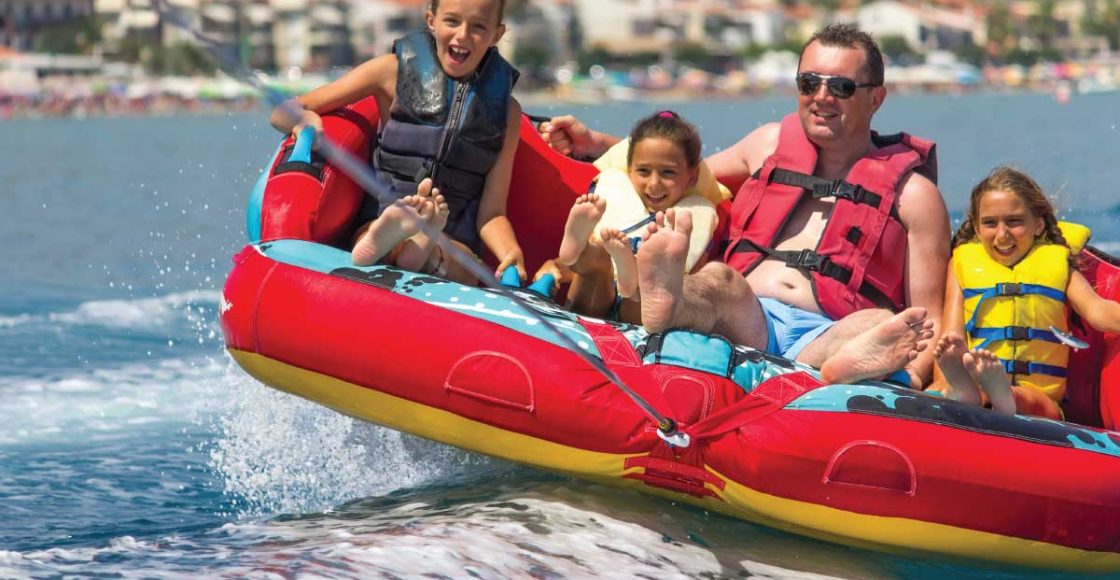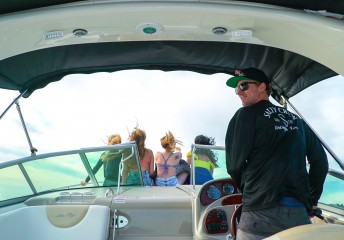How to Pull a Tube Behind a Boat Safely
Last Updated on September 17, 2024 by Boatsetter Team
Like many water activities, tubing behind a boat is so much fun. Still, we shouldn’t get too carried away and ignore safety tips. An injury while tubing can ruin your day (or worse). So before you go out and have a blast, review these basic tips for towing a tube safely:
- Tubing directions
- Pumping air into the tube
- Using the correct tow rope
- Secure attachment
- Signals
- Operating the boat
Read all the way through for additional Pro tips.
Find available boat rentals near you or at a destination
Read the directions
Read the owner’s manual or instructions that come with your tube. Important things to note are the tube’s passage capacity, inflation pressure, tow rope specifications, and boat speed. Follow these guidelines. If you can’t find the physical copy of the instructions, you can check the manufacturer’s website for it.
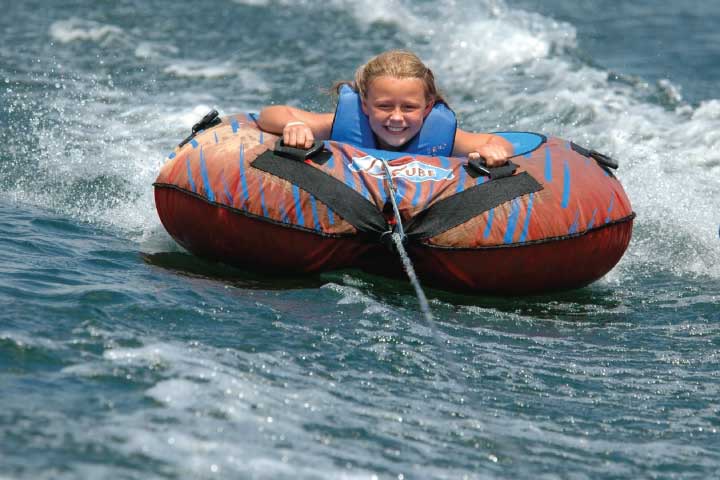
Pumping air into the tube
The correct amount of air in the water tube is essential to ensure you have a good time and the tube has a long life! You’ll know you have inflated the tube properly when the cover is tight and wrinkle-free. Here’s a quick Pro tip
For every 10-degree temperature drop, the innertube will lose around 1 psi, making it start to deflate. Check the predicted water temperature during your upcoming water tubing excursion and prepare by bringing an electric air pump.
Use the correct tow rope
Your tow rope should be your trusty steed! Make sure to follow these tips to select the best tubing tow rope
- Water tube tow ropes must be at least 50 ft but should not exceed 65 ft.
- Your rope should match the tube manufacturer’s strength specification. A rope designed for a two-person tube may snap if used to tow four people.
- Inspect your rope before use. Every time.
- Never use a rope that has knots, is frayed, or is sun damaged.
- Use a tow rope designed for tubing, specifically. Water ski and wakeboard tow ropes are not designed to pull the weight of a tube.
- When not in use, store the tow rope out of the sun.
Visit the Water Sports Industry Association (WSIA) for full guidelines.
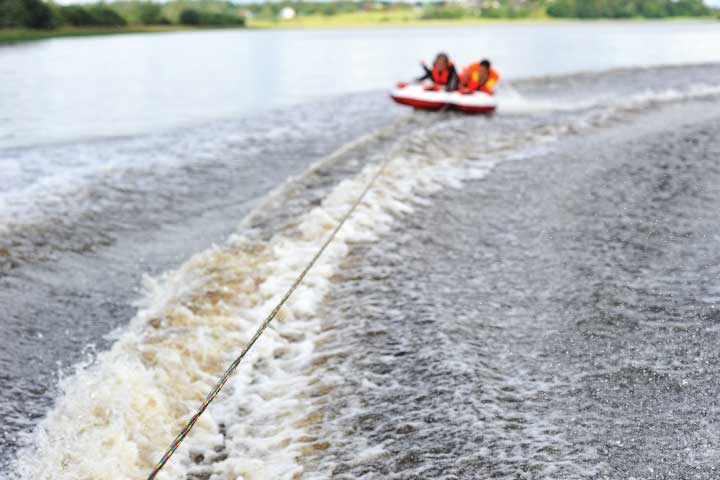
How to Tie a Tube to a Boat
Only attach the tube tow rope to a point on the boat designed for that purpose. You may attach the tube tow rope at the transom “ski eye” or transom U-bolt tow point or a tow pylon on the transom. Never attach the rope to a cleat or to the engine.
Also, never tow a tube from a wakeboarding or sport tower. The tower may not be strong enough, and the elevated position of the rope will tend to pull upward on the tube, causing it to perform poorly.
Always follow the tube manufacturer’s instructions for attaching the rope to the tube.
Know the hand signals
Know the correct hand signals to communicate with the licensed captain. Use any of the tubing hand signals to communicate the following
- Thumb[s] up- Go faster!
- Thumb[s] down- Slower, please.
- Pat the top of your head- I’m done; please stop. Or head for home.
- One arm extended: A tuber fell off.
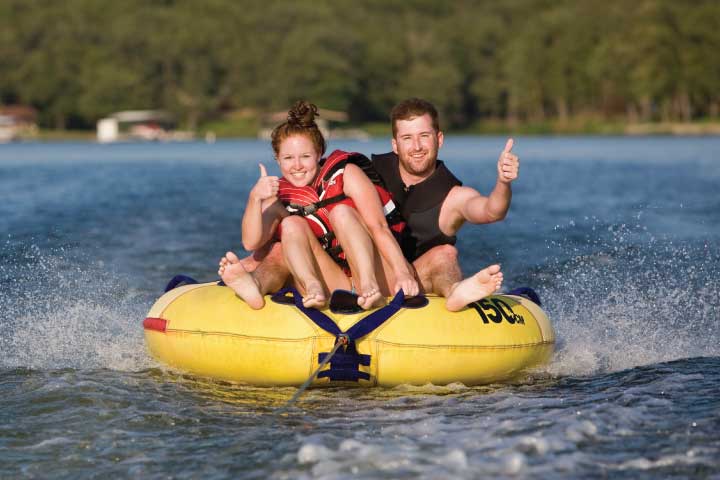
Operating the boat for tubing
If you haven’t booked a boat with one of our trusted captains, this means you plan on taking the helm yourself. No pressure, but you will be responsible for the safety of your crew. Here are some safety tips for renters operating their boat rental
- Be aware of all regulations regarding watersports and towing in your state. For information on boating laws by state, visit the National Association of State Boating Law Administrators’ (NASBLA).
- Always use a wide-angle rear-view mirror (a “ski mirror”) and have an adult spotter on board, facing aft, to watch the tube and riders. Both may be required by your state.
- Be aware of docks, jetties, and other boats when whipping the tube outside the boat wake. Avoid towing in congested areas and busy channels. A rider ejected from the tube can skim over the water for some distance. Pro tip: A good rule of thumb is to maintain at least 100 feet of distance from any dock or shore, and more room is always better.
- How fast? Keep the boat speed between 8 to 12 mph for small kids. For teenagers and adults, it’s okay to speed up to 15 to 20 mph. The ideal towing speed depends on the rider’s comfort and water conditions. You’ll need to slow down when the water is rough.
- When making a turn with the boat, the speed of the tube can double that of the boat – the boat turning at 20 mph can propel the tube to a speed over 40 mph, which may be uncomfortable for many riders, especially young riders. The point of tubing is to have fun, not to terrify your riders.
- Accelerate gradually so as not to jerk the slack in the tow rope. Sudden acceleration can cause riders to fall off.
- Start with the tube directly behind the boat, and let your riders get comfortable on the tube before making turns.
- Do not pull more than one tube at a time. Tubes crossing paths and colliding can be very dangerous and cause serious injuries to the riders. It’s probably also illegal in your state.
- If a tuber falls off, the spotter should keep an eye on them until you pick them up, so you can focus on driving the boat. Approach the tuber slowly so as not to make a wake, and approach from downwind so that the boat will not drift over the tuber. When possible, approach so that the person in the water is on the boat’s helm, allowing the captain to see them. Shut off the engine when you reach the tuber, and leave it off until they are in the boat or back on the tube.
- Of course, all tubers should wear a life jacket. Make sure it’s a good fit for the tuber.
Towing a tube should be an easy and fun joy ride. Just keep it safe. Discover more to do on a boat, like water skiing, wakeboarding, and snorkeling, at Boating Resources & Guides.
About us
Boatsetter is the leading online marketplace for boat rentals and on-water experiences. Download the Boatsetter app (App Store | Google Play) and follow us on Instagram.

Charles Plueddeman is a self-employed writer and photographer based in Wisconsin. A staff editor and contributor to Boating Magazine since 1986, he is the author of its “Off My Dock” column. In the marine realm he specializes in engine technology and trailerable boats. His editorial work has appeared in many national publications, including Popular Mechanics, Men’s Journal, Playboy, Popular Science, Cycle World, and Harley-Davidson Enthuisast.
